AP Unit 8: Clinical Psychology (copy)
1/98
Earn XP
Description and Tags
Myers unit 12: Abnormal Psychology Myers unit 13: Treatment of Psychological Disorders
Name | Mastery | Learn | Test | Matching | Spaced |
|---|
No study sessions yet.
99 Terms
Psychological Disorder
a syndrome marked by a clinically significant disturbance in an individual’s cognition, emotion regulation, or behavior.
To be clinically diagnosed with a disorder it has to significantly impair your everyday normal functioning
Medical Model
the concept that diseases, in this case psychological disorders, have physical causes that can be diagnosed, treated, and, in most cases, cured, often through treatment in a hospital.
Epigenetics
the study of environmental influences on gene expression that occur without a DNA change.
DSM-5
the American Psychiatric Association’s Diagnostic and Statistical Manual of Mental Disorders, Fifth Edition; a widely used system for classifying psychological disorders.
attention-deficit/hyperactivity disorder (ADHD)
a psychological disorder marked by extreme inattention and/or hyperactivity and impulsivity.
Key Indicators
Inattention
Hyperactivity: Excessive fidgeting, restlessness, or an inability to stay seated when it is expected.
Impulsivity (Can’t wait their turn, blurting out answers before questions are finished, acting without considering consequences, etc.)
Executive Functioning Challenges (difficulties with skills like organization, time management, and planning)
Emotion regulation issues
Impaired working memory
Poor Academic or Occupational Performance although very capable (not always, but can be a factor)
anxiety disorders
psychological disorders characterized by distressing, persistent anxiety or maladaptive behaviors that reduce anxiety.
Key Indicators:
Persistent symptoms present for at least six months
excessive worry
specific triggers
Physical symptoms: rapid heartbeat, sweating, trembling, shortness of breath, dizziness, gastrointestinal issues
Intense negative response to stress
panic attacks
social anxiety disorder
Intense fear and avoidance of social situations. (Formerly called social phobia.)
become extremely anxious in social settings where others might judge them, such as parties, class presentations, or even eating in public.
generalized anxiety disorder
an anxiety disorder in which a person is continually tense, apprehensive, and in a state of autonomic nervous system arousal.
marked by excessive and uncontrollable worry that persists for six months or more
Concentration is difficult as attention switches from worry to worry.
Their tension and apprehension may leak out through furrowed brows, twitching eyelids, trembling, perspiration, or fidgeting from autonomic nervous system arousal.
panic disorder
an anxiety disorder marked by unpredictable, minutes-long episodes of intense dread in which a person may experience terror and accompanying chest pain, choking, or other frightening sensations; often followed by worry over a possible next attack.
recurrent panic attacks
symptoms such as palpitations, sweating, trembling, shortness of breath, chest pain, nausea, dizziness, or a feeling of unreality.
worry about future attacks
must persist for at least a month
agoraphobia
fear or avoidance of situations, such as crowds or wide open places, where one has felt loss of control and panic.
phobia
an anxiety disorder marked by a persistent, irrational fear and avoidance of a specific object, activity, or situation
Phobia vs. Fear
Intensity and Irrationality
Phobia is more intense and irrational. Oftentimes a phobia elicits a disproportionate level of fear and anxiety compared to the actual threat
Duration
Phobias are more persistent and enduring, even when individual recognizes their fear is irrational they cannot control it unless treated.
Impact on life
Phobias significantly impact daily life and decision making as people will actively avoid certain situation, places, or activities, which can sometimes be impossible.
specificity
Phobias are always tied to a specific stimulus while fears can be broaderobsessive-compulsive disorder (OCD)
obsessive-compulsive disorder (OCD)
a disorder characterized by unwanted repetitive thoughts (obsessions), actions (compulsions), or both.
Obsessive thoughts are unwanted and so repetitive it may seem they will never go away. Compulsive behaviors are often responses to those thoughts
Thoughts and behaviors are time consuming
Cause clinically significant distress
Impairment in social, occupational, or other areas of social functioning
Example:
checking to see of the door is locked is normal, checking it 10 times in a matter of 10 minutes is not
Obsessions may include themes such as contamination, harming others, symmetry, or intrusive sexual or religious thoughts, among others. Compulsions may involve behaviors such as handwashing, checking, counting, arranging, or mental rituals such as praying or repeating words silently.
posttraumatic stress disorder (PTSD)
a disorder characterized by haunting memories, nightmares, hypervigilance, social withdrawal, jumpy anxiety, numbness of feeling, and/or insomnia that lingers for four weeks or more after a traumatic experience.
Usually affect survivors and witnesses of accidents, disasters, and violent and sexual assaults
The higher the distress, such as the level of physical torture suffered by prisoners of war, the greater the risk for posttraumatic symptoms
There must be:
Exposure to a traumatic Event
the re-experiencing of the traumatic event (nightmares, flashbacks, memories,
Intense psychological distress or physiological reactions to cues that resemble the traumatic event
Avoiding thoughts, feelings, or conversations related to the trauma, as well as avoiding places, people, or activities that may trigger memories of the event.
Negative alterations in cognition and mood (Persistent negative emotions, negative beliefs of expectations, decreased interest in activities, social detachment, hard time experiencing positive emotions)
Arousal and Reactivity (not always): Irritability, aggression, reckless or self-destructive behavior, hypervigilance, exaggerated startle response, problems with concentration, and sleep disturbances.
major depressive disorder
a disorder in which a person experiences, in the absence of drugs or another medical condition, two or more weeks with five or more symptoms, at least one of which must be either (1) depressed mood or (2) loss of interest or pleasure.
Symptoms
Feelings of sadness, hopelessness, and loss of interest in most activities
Changes in appetite or weight, sleep disturbances, fatigue, feelings of worthlessness or guilt, difficulty concentrating, thoughts of death or suicide
Problems in thinking, concentrating, or making decisions
repetitive thoughts of death and suicide
Reduced energy levels
Must have episodes that last from weeks to months
Bipolar disorder
a disorder in which a person alternates between the hopelessness and lethargy of depression and the overexcited state of mania.
Symptoms
Presence of Manic or Hypomanic Episodes
Presence of Major Depressive Episodes that last at least 2 weeks
Alternation between depressive and manic/hypomanic episodes
must cause clinically significant distress or impairment in social, occupational, or other important areas of functioning
mania
a hyperactive, wildly optimistic state in which dangerously poor judgment is common.
Symptoms:
elevated mood
increased energy levels
racing thoughts
impulsivity and risky behavior
decreased need for sleep
Grandiosity and perceived invincibility
rumination
compulsive fretting; overthinking our problems and their causes
Nonsuicidal self injury
What is it?
Such behavior, though painful, is not fatal.
Inidividuals may cut or burn their skin, hit themselves, insert objects under their nails or skin, or self-administer tattoos.
The goal is NOT suicide. Usually people who engage are suicide gesturers, not attempters. (However can escalate into suicide attempts)
People who engage in NSSI tend to experience bullying, harassment, and other life stress
Why?
find relief from intense negative thoughts through the distraction of pain.
attract attention and possibly get help.
relieve guilt by punishing themselves.
get others to change their negative behavior (bullying, criticism).
fit in with a peer group.
psychotic disorders
a group of disorders marked by irrational ideas, distorted perceptions, and a loss of contact with reality.
Diagnosis requirements:
Presence of one or both of the following symptoms:
hallucinations
delusions
symptoms must be present for a significant portion of time during a one-month period
must significantly impact the individual's functioning.
hallucinations
false sensory experiences, such as seeing something in the absence of an external visual stimulus.
schizophrenia
a disorder characterized by delusions, hallucinations, disorganized speech, and/or diminished, inappropriate emotional expression.
Diagnoses Requirements:
Presence of 2 or more of the following symptoms:
Delusions
hallucinations
disorganized speech
Grossly disorganized or catatonic behavior
Catatonic behavior involves a marked decrease in reactivity to the environment, which can include immobility, rigidity, or repetitive, purposeless movements.
Diminished and Inappropriate Emotions
continuous signs of disturbance persist for at least six months, with at least one month of active-phase symptoms (i.e., delusions, hallucinations, disorganized speech) present.
must significantly impair social, occupational, or other important areas of functioning
delusion
a false belief, often of persecution or grandeur, that may accompany psychotic disorders.
chronic schizophrenia
a form of schizophrenia in which symptoms usually appear by late adolescence or early adulthood. As people age, psychotic episodes last longer and recovery periods shorten.
acute schizophrenia
a form of schizophrenia that can begin at any age; frequently occurs in response to a traumatic event.
somatic symptom disorder
a psychological disorder in which the symptoms take a somatic (bodily) form without apparent physical cause. (Formerly called somatoform disorder; see conversion disorder and illness anxiety disorder.)
Basically having symptoms that cant be scientifically explained
Diagnosis Requirements:
The individual experiences one or more physical symptoms that are distressing and/or disruptive to daily life. These symptoms may be specific (e.g., pain, fatigue, gastrointestinal distress) or nonspecific (e.g., general discomfort).
🌟The individual experiences disproportionate and persistent thoughts, feelings, or behaviors in response to the somatic symptoms, such as excessive worry, anxiety, or preoccupation with their health or the severity of their symptoms.
The symptoms are persistent, typically lasting for six months or longer.
The symptoms cause significant impairment in social, occupational, or other important areas of functioning, or they lead to excessive use of healthcare resources (e.g., frequent doctor visits, unnecessary medical tests or procedures).
The somatic symptoms cannot be fully explained by another medical condition
Clinicians rate the severity of SSD based on the patients experience with the cognitive symptoms rather than the physical ones
conversion disorder
a disorder related to somatic symptom disorder in which a person experiences very specific, physical symptoms that are not compatible with recognized medical or neurological conditions. (Also called functional neurological symptom disorder.)
anxiety/stress → physical symptom → symptom unexplained by medical testing
For example: As a result to a stressful event a patient may all of a sudden develop impaired balance or loss of sensation in their finger
Diagnosis Requirements:
One or more symptoms of altered voluntary motor or sensory function: Examples include weakness or paralysis, abnormal movements, loss of sensation, or episodes resembling seizures.
Clinical findings: There must be evidence of incompatibility between the symptom and recognized neurological or medical conditions. (unable to be explained because there is no medical condition that exists to explain it)
Clinically significant distress or impairment: The symptoms cause clinically significant distress or impairment in social, occupational, or other important areas of functioning.
Not feigned or intentionally produced: The symptoms are not intentionally produced or feigned ( the patient is not faking it)
illness anxiety disorder
a disorder related to somatic symptom disorder in which a person interprets normal physical sensations as symptoms of a disease.
excessive worry or preoccupation with having a serious illness despite minimal or no medical evidence to support the presence of such an illness.
dissociative disorders
controversial, rare disorders in which conscious awareness becomes separated (dissociated) from previous memories, thoughts, and feelings.
dissociative identity disorder (DID)
a rare dissociative disorder in which a person exhibits two or more distinct and alternating personalities. (Formerly called multiple personality disorder.)
Diagnosis requirements:
Alter Personalities (Alters): The distinct identities in DID are often referred to as "alters." Each alter may have its own age, gender, mannerisms, voice, and even physical abilities.
Switching: Switching refers to the sudden transition from one alter to another. Switching may occur spontaneously, triggered by stress, trauma reminders, or internal conflicts.
🌟Amnesia: Individuals may experience partial or complete amnesia for events, behaviors, or experiences associated with different alters.
Trauma and Etiology: DID is often associated with a history of severe childhood trauma or abuse, particularly repeated and prolonged trauma that occurs during sensitive developmental periods. Traumatic experiences may lead to the fragmentation of identity as a coping mechanism to protect the individual from overwhelming emotions or experiences.
Comorbidity: Depression, anxiety disorders, post-traumatic stress disorder (PTSD), substance use disorders, and other dissociative disorders.
personality disorders
inflexible and enduring behavior patterns that impair social functioning
antisocial personality disorder
a personality disorder in which a person (usually a man) exhibits a lack of conscience for wrongdoing, even toward friends and family members; may be aggressive and ruthless or a clever con artist.
also have a lack or remorse
usually male
can display symptoms around age 8, lack of consciousness becomes unignorable before age 15
begin to lie, steal, fight, or display unrestrained sexual behavior
may show lower emotional intelligence
People with this disorder are also known as sociopaths or psychopaths
Note: antisocial in this case means ‘disruptive’ not necessarily ‘unsociable’
anorexia nervosa
an eating disorder in which a person (usually an adolescent female) maintains a starvation diet despite being significantly underweight; sometimes accompanied by excessive exercise.
bulimia nervosa
an eating disorder in which a person’s binge eating (usually of high-calorie foods) is followed by inappropriate weight-loss promoting behavior, such as vomiting, laxative use, fasting, or excessive exercise.
binge-eating disorder
significant binge-eating episodes, followed by distress, disgust, or guilt, but without the compensatory behavior that marks bulimia nervosa.
psychotherapy
treatment involving psychological techniques; consists of interactions between a trained therapist and someone seeking to overcome psychological difficulties or achieve personal growth.
Goal oriented: Psychotherapy typically involves setting specific, measurable goals for therapy and working towards achieving these goals over the course of treatment.
Therapeutic Relationship: the client and patient must develop a trusting, healthy relationship
Focus on Psychological Processes: Psychotherapy focuses on understanding and addressing psychological processes, such as thoughts, emotions, behaviors, and interpersonal relationships.
social statues, culture, and gender all can affect the likelihood of someone seeking treatment
(talk therapy)
biomedical therapy
prescribed medications or procedures that act directly on the person’s physiology.
Ex: a person with severe depression may receive antidepressants, electroconvulsive shock therapy (ECT), or deep-brain stimulation
eclectic approach
an approach to psychotherapy that uses techniques from various forms of therapy
A mixture of psychotherapy and biomedical therapy
psychoanalysis
Sigmund Freud’s therapeutic technique. Freud believed the patient’s free associations, resistances, dreams, and transferences—and the therapist’s interpretations of them—released previously repressed feelings, allowing the patient to gain self-insight.
Goal: achieve healthier, less anxious living by releasing the energy they had previously devoted to id-ego-superego conflicts
Ideology: We repress threatening things we don’t want to know. Psychoanalysis was the method for helping people to bring these repressed feelings into conscious awareness. By helping them reclaim their unconscious thoughts and feelings, and by giving them insight into the origins of their disorders, the therapist (analyst) could help them reduce growth-impeding inner conflicts.
Technique and Methodology:
Patient is lying on couch relaxing
The psychoanalyst, who sits out of line of vision, asks to say aloud whatever comes to mind.
Soon patient notice how often they edit their thoughts as they speak. (resistance)
The analyst will note your resistance and then provide insight into its meaning. (interpretation)
resistance
in psychoanalysis, the blocking from consciousness of anxiety-laden material.
interpretation
in psychoanalysis, the analyst’s noting supposed dream meanings, resistances, and other significant behaviors and events in order to promote insight.
transference
in psychoanalysis, the patient’s transfer to the analyst of emotions linked with other relationships (such as love or hatred for a parent).
Example:
Let's say a client, Sarah, grew up with a critical and emotionally distant father. Throughout therapy sessions, Sarah finds herself becoming increasingly frustrated with her therapist, Dr. Jones, whenever he challenges her thoughts or behaviors. She notices that she starts to feel defensive and angry during these moments, even though Dr. Jones is offering support and guidance in a caring manner.
In this scenario, Sarah's feelings of frustration and defensiveness toward Dr. Jones may stem from her unresolved issues with her father. She may be projecting her father's critical and distant behavior onto Dr. Jones, leading her to react to the therapist as if he were her father.
psychodynamic therapy
therapy deriving from the psychoanalytic tradition; views individuals as responding to unconscious forces and childhood experiences, and seeks to enhance self-insight.
Some key differences between psychodynamic and psychoanalytic therapy:
Psychodynamic therapy may involve fewer sessions per week, often ranging from once to twice weekly.
Psychodynamic therapy also explores unconscious processes but may be less intensive and directive than psychoanalysis.
In the psychodynamic therapy the therapeutic relationship is also important, but the therapist may take a more active and supportive role. The therapist may offer empathy, validation, and encouragement, while also exploring the client's internal experiences and relational patterns.
Psychodynamic therapy has evolved to incorporate a broader range of theoretical perspectives and therapeutic techniques
(You don’t need to name the differences, but essentially psychodynamic therapy is an evolved version of psychoanalytic)
insight therapies
What psychodynamic and humanistic therapies are often known as
therapies that aim to improve psychological functioning by increasing a person’s awareness of underlying motives and defenses.
Humanistic therapy
approach to psychotherapy that emphasizes the individual's capacity for self-awareness, self-growth, and self-actualization.
Some factors that define humanistic therapy:
Humanistic therapists aim to boost people’s self-fulfillment by helping them grow in self-awareness and self-acceptance.
Promoting this growth, not curing illness, is the therapy focus. Thus, those in therapy have become “clients” or just “persons” rather than “patients”
The path to growth is taking immediate responsibility for one’s feelings and actions, rather than uncovering hidden determinants.
Conscious thoughts are more important than the unconscious.
The present and future are more important than the past. Therapy thus focuses on exploring feelings as they occur, rather than on achieving insights into the childhood origins of those feelings.
client-centered therapy
a humanistic therapy, developed by Carl Rogers, in which the therapist uses techniques such as active listening within an accepting, genuine, empathic environment to facilitate clients’ growth.
Methodology:
Creating a Therapeutic Relationship: The therapist establishes a warm, empathetic, and nonjudgmental relationship with the client.
Active Listening: The therapist practices active listening, paying close attention to the client's verbal and nonverbal communication.
Empathetic Understanding: The therapist seeks to deeply understand the client's subjective experience, emotions, and perspectives helping the client feel validated
Unconditional Positive Regard: The therapist accepts them without judgment or evaluation. This fosters a sense of safety and trust in the therapeutic relationship, allowing the client to explore their thoughts and feelings openly.
Facilitating Self-Exploration: The therapist encourages the client to explore their thoughts, feelings, and experiences more deeply. This may involve asking open-ended questions, exploring areas of conflict or confusion, and encouraging the client to express themselves authentically.
Empowering the Client: Client-centered therapy emphasizes the client's autonomy and self-direction. The therapist supports the client in identifying their own goals, values, and aspirations, and encourages them to take ownership of their own growth and healing process.
Reflecting and Summarizing: Throughout the therapy session, the therapist provides reflections and summaries of the client's experiences, helping to clarify and deepen their understanding. This feedback loop allows the client to gain insight into their own thoughts and feelings.
active listening
empathic listening in which the listener echoes, restates, and clarifies. A feature of Rogers’ client-centered therapy.
unconditional positive regard
a caring, accepting, nonjudgmental attitude, which Carl Rogers believed would 1922 help clients develop self-awareness and self-acceptance.
behavior therapy
therapy that applies learning principles to the elimination of unwanted behaviors.
counterconditioning
behavior therapy procedures that use classical conditioning to evoke new responses to stimuli that are triggering unwanted behaviors; include exposure therapies and aversive conditioning.
Example:
Let's say someone has a phobia of dogs (cynophobia) and experiences intense fear and anxiety whenever they encounter a dog. Through systematic desensitization, the therapist helps the individual gradually learn to associate dogs with relaxation and calmness instead of fear.
Establishing a Hierarchy of Fear: The therapist works with the individual to create a hierarchy of fear, ranking situations involving dogs from least to most anxiety-provoking. For example, seeing a picture of a dog might be the least anxiety-provoking, while being in close proximity to a dog might be the most anxiety-provoking.
Learning Relaxation Techniques: Before exposure to the feared stimulus (dogs), the individual learns relaxation techniques such as deep breathing, progressive muscle relaxation, or visualization. These techniques help the individual to induce a state of relaxation and calmness.
Exposure to Gradual Desensitization: The individual is gradually exposed to situations involving dogs, starting with the least anxiety-provoking scenarios from the hierarchy. For example, they might begin by looking at pictures of dogs while practicing relaxation techniques. Once they can do this without experiencing significant anxiety, they move on to more challenging situations, such as being in the presence of a small, calm dog.
Pairing Exposure with Relaxation: During each exposure, the individual practices relaxation techniques to counteract feelings of fear and anxiety. By repeatedly pairing the presence of dogs with a relaxed state, the individual learns to associate dogs with relaxation instead of fear.
Reinforcement and Practice: Successful exposures are reinforced with positive reinforcement, such as praise or rewards, to strengthen the new association between dogs and relaxation. The individual continues to practice exposure exercises until they can comfortably tolerate being around dogs without experiencing significant anxiety.
exposure therapies
behavioral techniques, such as systematic desensitization and virtual reality exposure therapy, that treat anxieties by exposing people (in imaginary or actual situations) to the things they fear and avoid.
systematic desensitization
a type of exposure therapy that associates a pleasant relaxed state with gradually increasing anxiety-triggering stimuli. Commonly used to treat phobias.
You cannot simultaneously be anxious and relaxed. Therefore, if you can repeatedly relax when facing anxiety-provoking stimuli, you can gradually eliminate your anxiety.
virtual reality exposure therapy
a counterconditioning technique that treats anxiety through creative electronic simulations in which people can safely face their greatest fears, such as airplane flying, spiders, or public speaking.
Aversive Conditioning
a type of counterconditioning that associates an unpleasant state (such as nausea) with an unwanted behavior (such as drinking alcohol).
Example: A mother makes her kid smoke a pack of cigarettes so they’ll grow disgusted and not want to smoke anymore
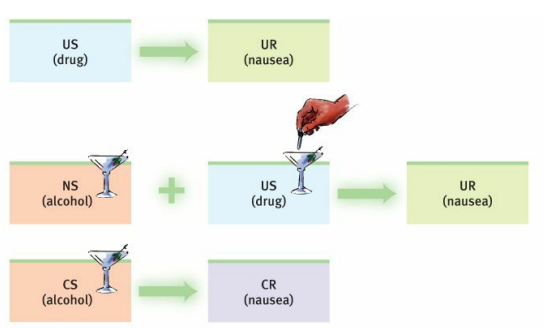
token economy
an operant conditioning procedure in which people earn a token for exhibiting a desired behavior and can later exchange tokens for privileges or treats.
Example:
Imagine a fifth-grade classroom where the teacher wants to promote positive behavior and academic engagement among students. The teacher decides to implement a token economy system to reinforce desired behaviors and create a more positive learning environment.
Token System Setup: The teacher introduces a token system where students can earn "tokens" for demonstrating ‘good’ behaviors.
Behavior Monitoring: Throughout the day, the teacher observes students' behavior and provides immediate feedback and reinforcement. Whenever a student demonstrates a desired behavior, such as raising their hand to ask a question or assisting a peer with a task, they receive a token as a reward.
Token Exchange: At the end of the day or week, students have the opportunity to exchange their tokens for rewards or privileges. The teacher creates a menu of rewards that students can "purchase" using their tokens, such as extra recess time, choosing a preferred activity, sitting in a special seat, or receiving a small prize or privilege.
The teacher consistently reinforces desired behaviors by consistently rewarding students with tokens when they occur. The token economy system is implemented consistently and fairly, ensuring that all students have equal opportunities to earn tokens and rewards, improving the amount of desired behaviors overtime
Controversy
Will people become so dependent on extrinsic rewards that the desired behaviors will stop when reinforcers stop?
Is it right for one human to control another’s behavior?
cognitive therapy
therapy that teaches people new, more adaptive ways of thinking; based on the assumption that thoughts intervene between events and our emotional reactions.
Belief that the person’s emotional reactions are produced not directly by the event but by the person’s thoughts in response to the event.

rational-emotive behavior therapy (REBT)
a confrontational cognitive therapy, developed by Albert Ellis, that vigorously challenges people’s illogical, self-defeating attitudes and assumptions.
Change people’s thinking by revealing the “absurdity” of their self defeating ideas, the sharp-tongued Ellis believed, and you will change their self-defeating feelings and enable healthier behaviors.
Selected Cognitive Therapy Techniques
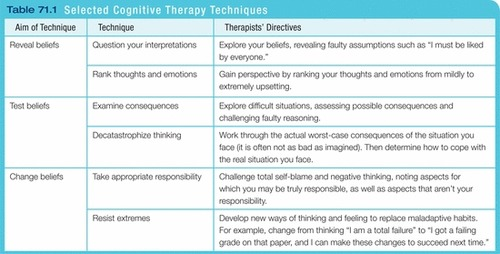
cognitive-behavioral therapy (CBT)
a popular integrative therapy that combines cognitive therapy (changing self defeating thinking) with behavior therapy (changing behavior).
This widely practiced integrative therapy aims to alter not only the way people think but also the way they act.
CBT seeks to make people aware of their irrational negative thinking and to replace it with new ways of thinking.
it trains people to practice the more positive approach in everyday settings
How is this different from REBT?
CBT also tackles behavior
RBT is more direct and confrontational than CBT
group therapy
therapy conducted with groups rather than individuals, providing benefits from group interaction.
Benefits:
saves therapists’ time and clients’ money, and often is just ass effective
It offers a social laboratory for exploring social behaviors and developing social skills.
It enables people to see that others share their problems. It can be a relief to discover that others, experience some of the same troublesome feelings and behaviors
It provides feedback as clients try out new ways of behaving. Hearing that you look poised, even though you feel anxious and self-conscious, can be very reassuring.
family therapy
therapy that treats people in the context of their family system. Views an individual’s unwanted behaviors as influenced by, or directed at, other family members.
self-help groups
voluntary associations of individuals who come together to share common experiences, concerns, or goals, and to provide mutual support, encouragement, and practical assistance to one another.
Comparing Modern Psychotherapies
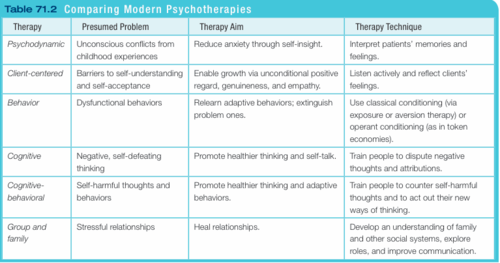
meta-analysis
a procedure for statistically combining the results of many different research studies.
evidence-based practice
clinical decision making that integrates the best available research with clinical expertise and patient characteristics and preferences.
After rigorous evaluation, clinicians apply therapies suited to their own skills and their patients’ unique situations
3 legged stool!
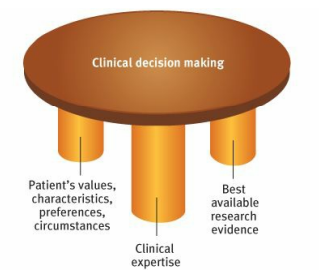
therapeutic alliance
a bond of trust and mutual understanding between a therapist and client, who work together constructively to overcome the client’s problem.
Therapists and Their Training
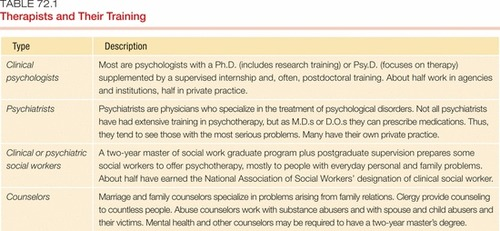
psychopharmacology
the study of the effects of drugs on mind and behavior.
antipsychotic drugs
drugs used to treat schizophrenia and other forms of severe thought disorder. Dampens responsiveness to irrelevant stimuli.
Side effects: sluggishness, tremors, and twitches similar to those of Parkinson’s disease
Ex: Thorazine
positive symptoms
involve the presence of abnormal experiences or behaviors that are not typically seen in healthy individuals. They "add" to a person's experiences or behavior.
Ex: Hallucinations, delusions, disorganized thinking or speech
negative symptoms
involve the absence or reduction of normal behaviors, experiences, or functions. They represent a diminution or "loss" of typical functioning.
Examples: Reduced emotional expression or blunted affect, Reduced motivation, Decreased ability to experience pleasure or enjoyment, social withdrawal
antianxiety drugs
Drugs used to control anxiety and agitation. Depress central nervous system activity (and so should not be used in combination with alcohol).
Side effects: addictive, fatigue, dizziness, memory impairment, confusion/disorientation, muscle weakness, sexual disfunction, weight changes
Ex: Xanax or Ativan
antidepressant drugs
Drugs used to treat depression, anxiety disorders, obsessive-compulsive disorder, and posttraumatic stress disorder. (Several widely used antidepressant drugs are selective serotonin reuptake inhibitors—SSRIs.) Increase the availability of neurotransmitters, such as norepinephrine or serotonin, which elevate arousal and mood and are scarce when a person experiences feelings of depression or anxiety.
Side effects: dry mouth, weight gain, hypertension, or dizzy spells
Ex: Prozac
electroconvulsive therapy (ECT)
a biomedical therapy for severely depressed patients in which a brief electric current is sent through the brain of an anesthetized patient.
repetitive transcranial magnetic stimulation (rTMS)
the application of repeated pulses of magnetic energy to the brain; used to stimulate or suppress brain activity
psychosurgery
surgery that removes or destroys brain tissue in an effort to change behavior
lobotomy
a psychosurgical procedure once used to calm uncontrollably emotional or violent patients. The procedure cut the nerves connecting the frontal lobes to the emotion-controlling centers of the inner brain.
usually decreases the person’s misery or tension, but also produces a permanently lethargic, immature, uncreative person
Comparing Biomedical Therapies
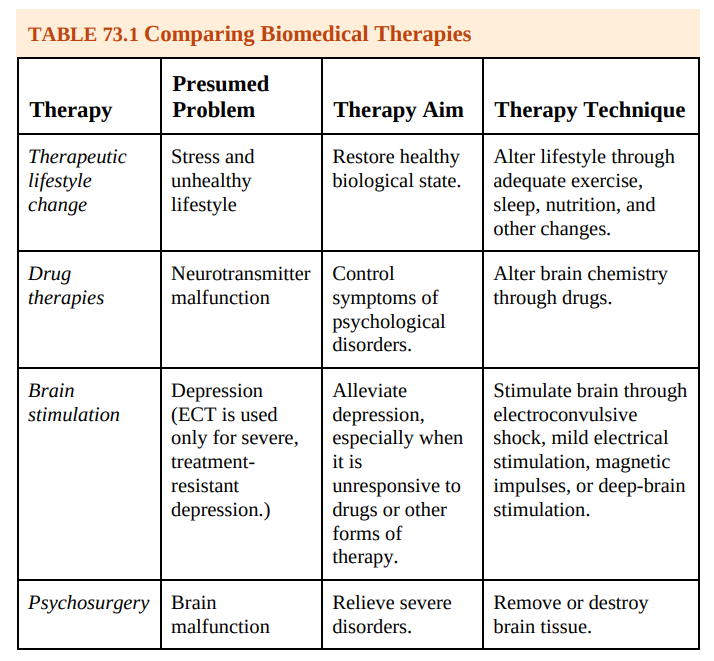
resilience
the personal strength that helps most people cope with stress and recover from adversity and even trauma.
posttraumatic growth
positive psychological changes as a result of struggling with extremely challenging circumstances and life crises.
No-wrong-door Model
a system ensuring individuals receive appropriate mental health services regardless of the entry point, promoting access and continuity of care.
Freud
Father of psychoanalysis, developed theories on the unconscious mind, dream interpretation, and the role of sexuality in human behavior.
Psychosexual Stages of Development
the childhood stages of development (oral, anal, phallic, latency, genital) during which, according to Freud, the id’s pleasure-seeking energies focus on distinct erogenous zones.
Free Association
in psychoanalysis, a method of exploring the unconscious in which the person relaxes and says whatever comes to mind, no matter how trivial or embarrassing.
Gestalt Therapy
humanistic approach to therapy that focuses on the present moment and emphasizes personal responsibility, awareness, and the integration of thoughts, feelings, and behaviors.
OH Mowrer
Developed the Two-Factor Theory of classical conditioning therapy, which combines both classical and operant conditioning techniques to treat phobias.
Mary Cover Jones
Behavior therapist known for her work in desensitization therapy, particularly with a child named Peter.
John Wolpe
South African psychiatrist known for developing systematic desensitization, a form of behavior therapy used to treat phobias and anxiety disorders.
Time Out
Clinical timeout:
3 minutes
10 seconds of silence
Positive Reinforcement
increasing behaviors by presenting positive reinforcers. A positive reinforcer is any stimulus that, when presented after a response, strengthens the response.
Aaron Beck’s Therapy for Depression
focuses on identifying and changing negative thought patterns to alleviate symptoms and improve mental well-being.
Dialectical Behavioral Therapy
type of cognitive-behavioral therapy that helps individuals manage emotions, develop coping skills, and improve interpersonal relationships.
Select Seratonin Reuptake Inhibitors (SSRI)
Work by partially blocking the reabsorption and removal of serotonin from synapses. Having more serotonin remain in the synapses has been shown to help reduce the symptoms of depression.
Side Effects: Nausea, Headache, Insomnia, Sexual dysfunction, Weight gain, Fatigue, Anxiety, Sweating, Dizziness.
Examples: Zoloft, Paxil, and Prozac
Serotonin and Norepinephrine Reuptake Inhibitors (SNRI)
Work by increasing the levels of serotonin and norepinephrine in the brain, helping to improve mood and alleviate symptoms of depression.
Stephen Illardi’s Model
holistic approach to treating depression, focusing on lifestyle factors like diet, exercise, sleep, and social connections.
Albert Ellis
Psychologist known for developing Rational Emotive Behavior Therapy (REBT), focusing on changing irrational beliefs to improve mental health and well-being.
Carl Rogers
Humanistic psychologist known for his person-centered approach, emphasizing empathy, genuineness, and unconditional positive regard in therapy.
B.F. Skinner
Psychologist known for operant conditioning. Believed behavior is shaped by consequences. Introduced concepts like reinforcement and punishment in behaviorism.
Mood-Stabilizing Medications (example and side effects)
Drugs used to treat mood disorders like bipolar disorder. They help regulate mood swings and prevent extreme highs and lows.
Side Effects: Weight gain, drowsiness, tremors, thyroid problems
Examples: Lithium, Valproic Acid, Lamotrigine
Response cost
taking away desirable possessions, points, tokens, or privileges in planned, incremental steps following the occurrence of undesirable behavior or failure to meet a specific goal.